

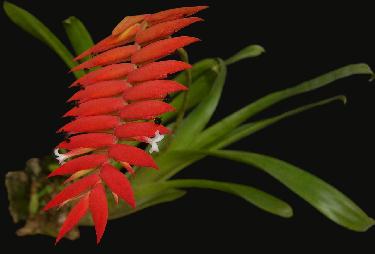



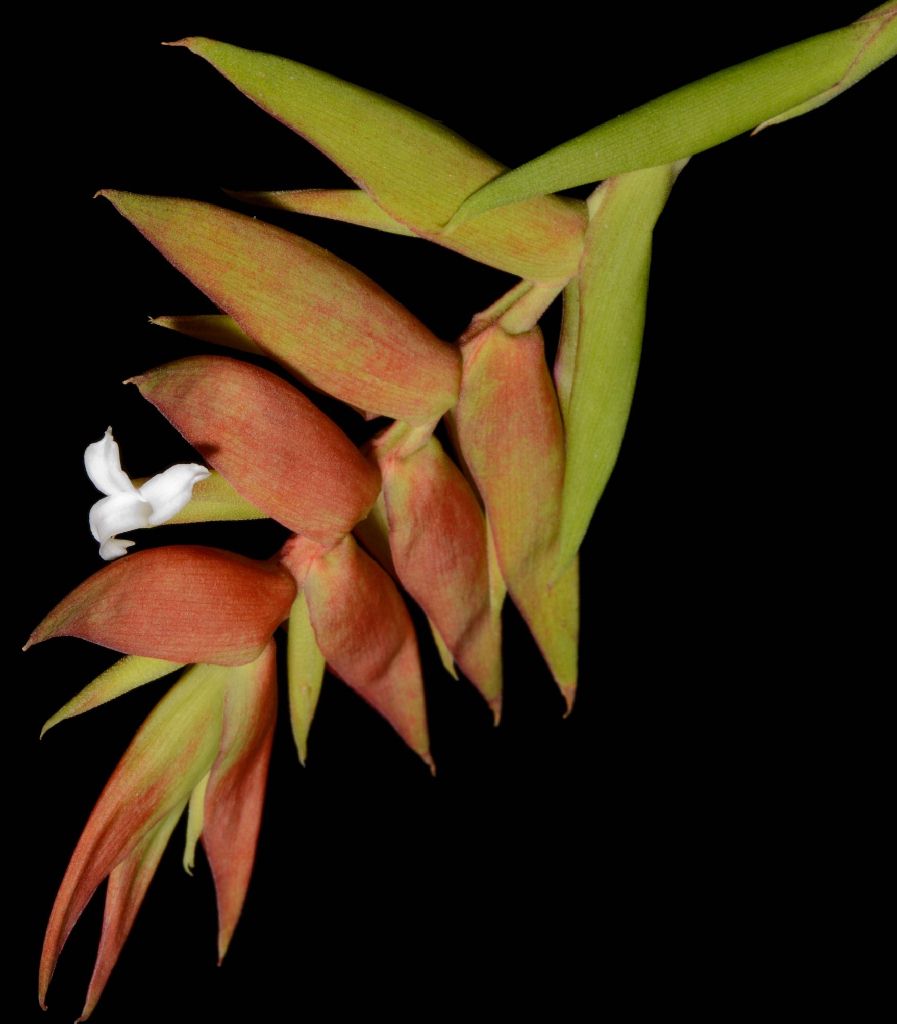
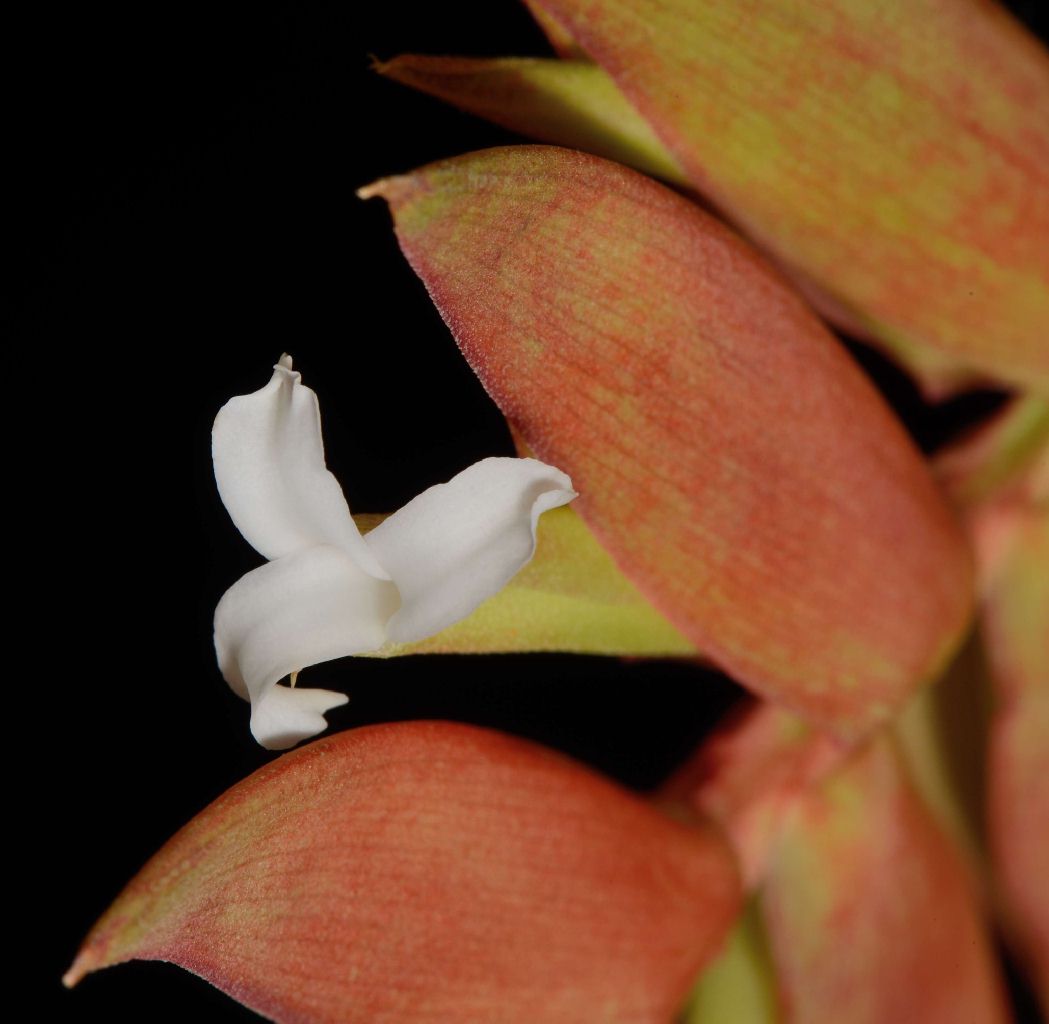
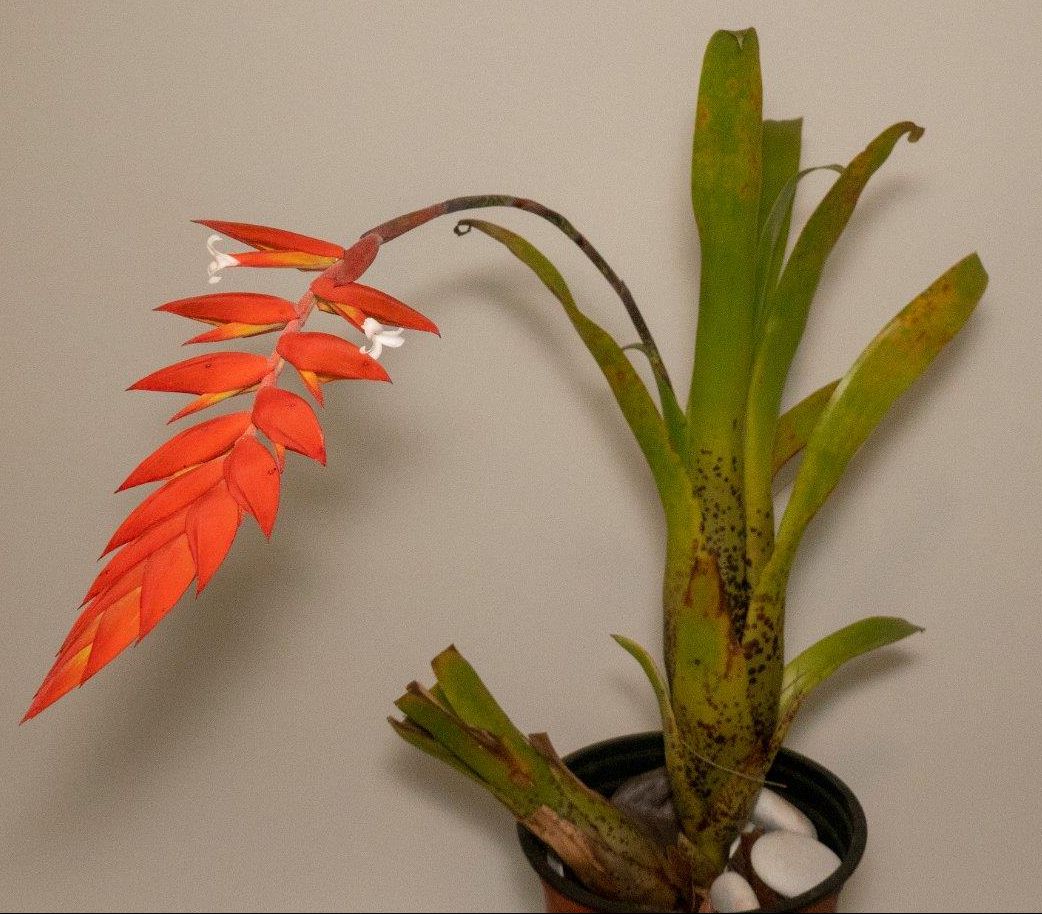

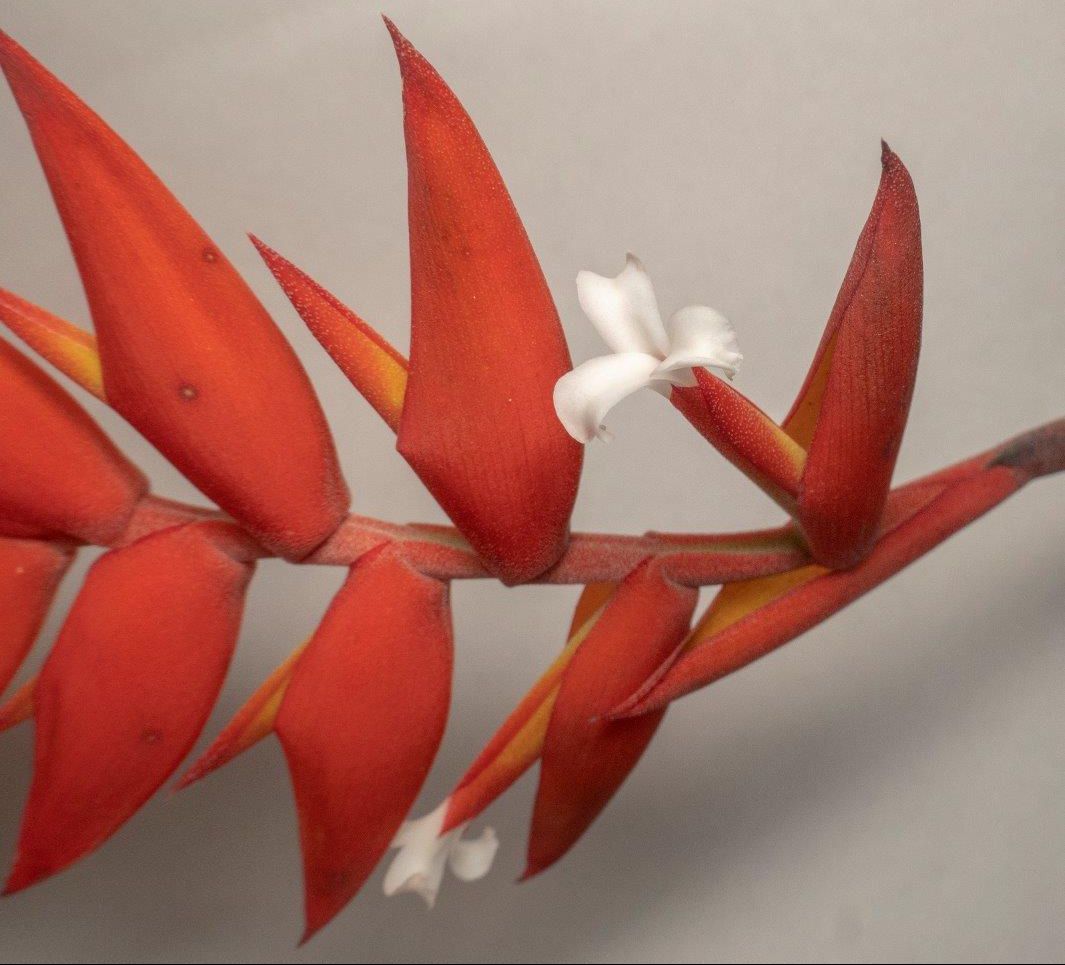


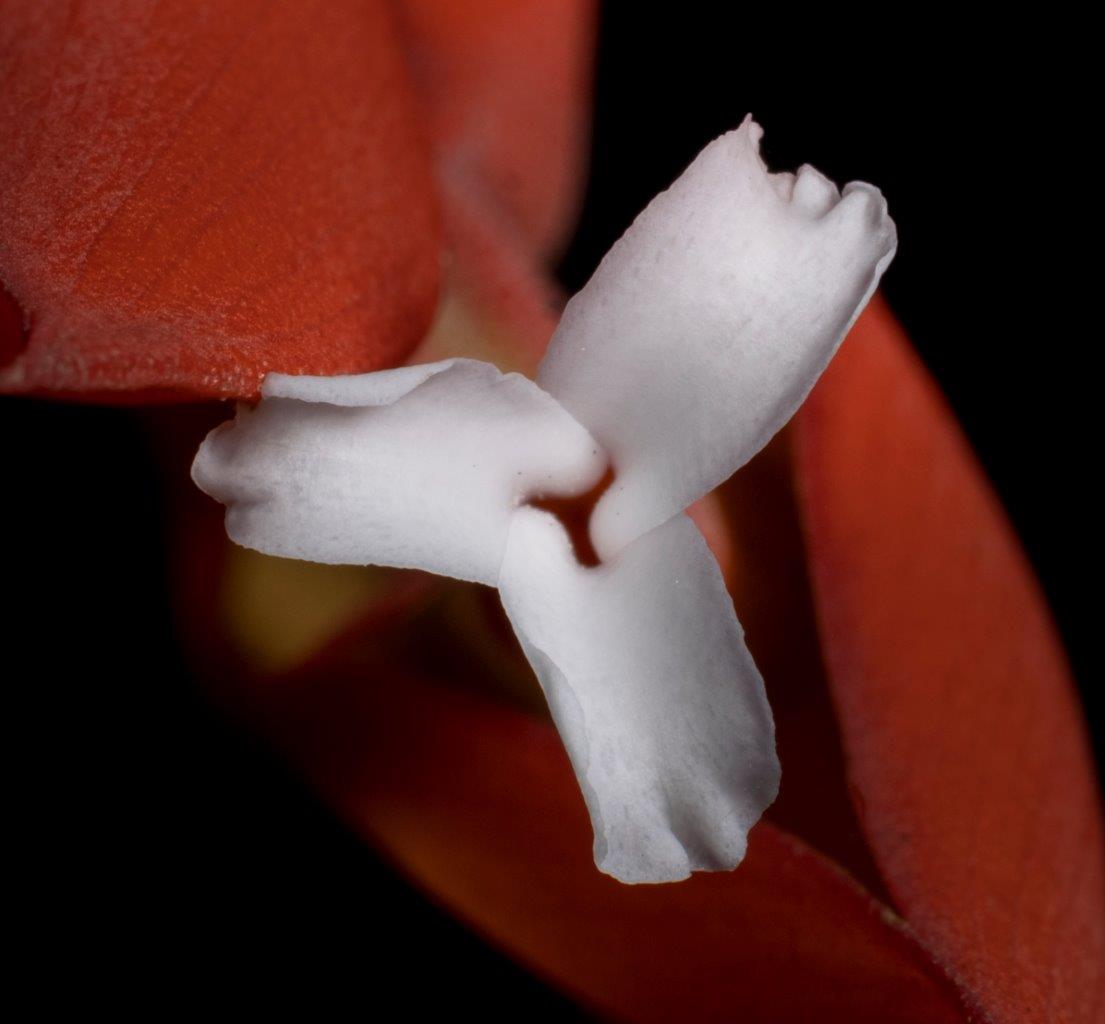
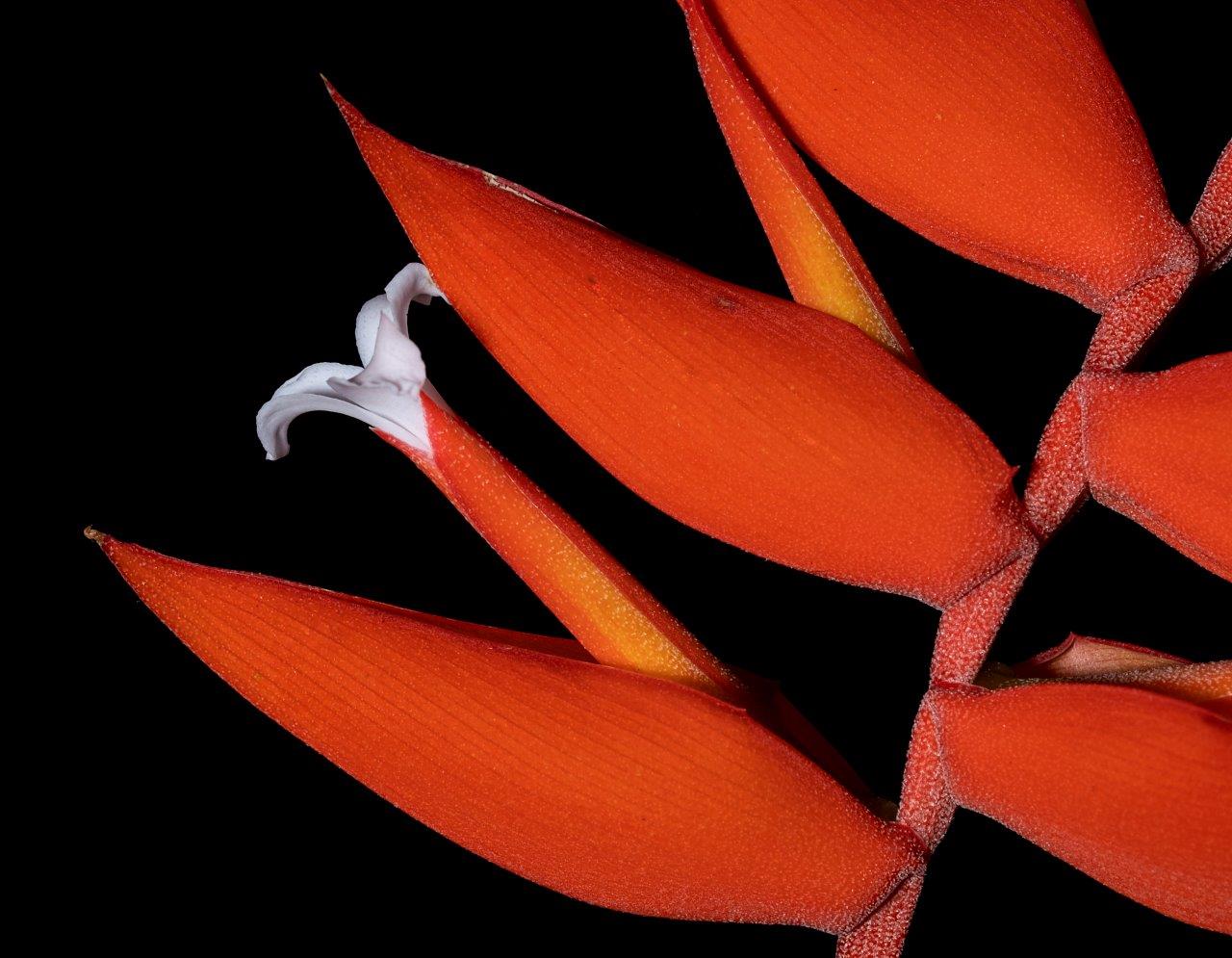
Tillandsia rutschmannii W Rauh Trop. Subtrop. Pflanzenwelt 12:19-26 1974 Considered synonymous with T. dyeriana by Rauh in Trop. Subtrop. Pflanzenwelt 27: 441-2. 1979
Planta acaulis, florifera ad 45 cm alta. Folia pauca, rosulam infundibuliforrnem gracilem basi modice bulbosam formantia, exteriora multo breviora quam interiora. Vagina inconspicue limitata, late ovalis, 8-10 cm longa, ad 3,5 cm lata, utrimque lepidota, supra atroviolacea vel tantum atroviolaceo-maculata. Lamina lingulata, 15-20 cm longa, ad.2,5 cm lata, apice recurvato, viridis, utrimque disperse lepidota, basi interdum atroviolaceo-maculata. Scapus inflorescentiae erectus, in parte superiore incurvus, leniter flexuosus, ad 35 cm longus, folia perlonge superans, 3 mm diametiens, teres, viridis, glaber. Folia scapi erecta, vaginis longis amplectentibus scapum et laminis brevissimis patentibus, vix longiora quam internodia, viridia, atroviolaceo-maculata, margine rubro-limbata, appresso-cano-lepidota. Inflorescentia simplex, raro composita e spicis duabus, rectangulariter patens vel incurve pendens. Spica usque ad 15 cm longa, sub anthesim 6 cm lata, complanata, plus minusve 21-flora, axe applanato, recto, lepidoto, viridi vel splendenti-rubro. Bracteae florales distichae, ante anthesim congestae, carinatae, sub anthesim laxe dispositae, axis spicae itaque visibilis, ecarinatae, fere rectangulariter ab axe patentes, laeves, enervatae, glabrae, tantum basi disperse lepidotae, aurantiacae vel splendenti-cinnabarinae, multo longiores quam sepala, usque ad 3 cm longae, 2 cm latae, in apicem acrem uncinaturn excurrentes. Sepala usque ad 2,5 cm Ionga, 6 mm lata, lanceolato-acuminata, libera, ecarinata, basi viridia, apicem versus rubescentia, disperse lepidota, Petala alba, in statu desiccandi atra, apicibus reclinatis obtusis, usque ad 2,5 cm longa, 3 mm lata. Antherae et stylus profunde inclusae.
Habitat : Ecuador orientalis, Sucua (Prov. Morona Santiago) in silva montium apud 1500 m. s. m.
Holotypus : no. collect. 31701 in herbario inst. bot. system. Heidelbergensis (HEID); Isotypus in U.S. Nat. Herb. Washington
Tillandsia rutschmannii similis Tillandsiae dyerianae, sed ab ea differt inflorescentibus plerumque simplicibus et bracteis floralibus splendenti-rubris.
Plant stem-less, to 45 cm high, upright, at the base a weakly bulbose rosette, whose outer leaves are much shorter than the inner ones.
Sheath inconspicuous, wide oval, 8-10 cm long, approximately 3.5 cm wide and on both sides dense appressed scaled, upper side either uniformly dark-violet or matching the underside - green and only black-violet stained.
Blade ligulate, 10-25 cm long, above the sheath to 2.5 cm wide, upright, narrowing to a bent over tip, scaled rather densely when young, however with increasing age glabrous and only scattered lepidote and then shiny-green; its black-violet flecks seems to occur in sun exposed plants
Scape thin, upright at the base, in the upper half bent over and lightly flexuous, round, glabrous , 3 mm thick, well exceeding the rosette-leaf with laxly arranged scape bracts.
Scape bracts approximately 3 cm long, green, red edged, grey lepidote, sometimes dull spotted, the sheath covers the internodes, and exceeded by a short 3 angled erect standing blade.
Inflorescence mostly simple, initially a dense egg shaped acuminate terminal spike, rarely with another, at most two, (according to Rutschmann), and further the side spikes are smaller, The prefloral long-like-oval, acuminate, almost rectangular spike sticks out from the scape
Spike elongates so that at the time of the anthesis, is up to 15 cm long and 6 cm wide with many lax flowers.
Rhachis weakly geniculate, angular flattened, green or shining vermilion, lepidote, is then visible.
Floral bract distichously arranged, upright and extremely carinate at the bud stage, spreading to horizontal at the time of anthesis, and widens out with it. exceeding the flower, to 3 cm long, (and when extended) to 2cm wide, narrowing into a sharp, hooked bent tip, smooth, not nerved, glabrous, leathery, with scattered scales at the sessile base, colour varies, according to light intensity, from orange-yellow to shining vermilion red. The intense colour is not caused through anthocyanin but through karotine.
Sepal to 22 mm long and to 6 mm wide, lanceolate acuminate, ecarinate, free, scattered lepidote, at the base greenish, towards the top reddish.
Petal white, ligulate, up to 2.5 cm long and to 3 mm wide, at the top spreading until bent over, postfloral intensively black.
Stamen and Style deeply enclosed.
Holotype: No.31701 in the Herb. Inst. Bot. University of Heidelberg; Isotype: U.S. Nat. Mus. Washington.
T. rutschmannii was found only once until now, in fact near Sucua, valley of Sucua, Prov. Morona Santiago (East-Ecuador) in a degraded mountain-forest at 1500 m high. Dr. Rutschmann remarked about the intensive colour of the floral bracts because there is no other comparable Tillandsia. The late Dr. Naundorff, Quito-Ecuador, gave it the name "la pintada", probably because of the flecking of the leaf, as Dr Naundorff had not seen the plant in flower.
T. rutschmannii, a species of Phytarrhiza, is similar to Tillandsia dyeriana ANDRE and which comes from the same area. See “The Bromeliaceae 0f Ecuador " by A. .J. GILMARTIN (1972) only that the Type locality from Andre (No.4256), Prov. El Oro, approximately 100 m (or thereabouts). We however found T. dyeriana on the old Quito road (Guayaquil-Quevedo-Quito) to 800 m high near Heda. Selva negra, collection No. 34448, and between Bahia and Sto. Domingo, 400 m; collection No. 34883). As far as until today known, T. dyeriana seems to grow in low situations (400-800 m) on the west side of theAndes. Whereas T. rutschmannii up to now only has been found on the east side of the Cordillera.
Both types have ligulate acuminate dull purple spotted leaves, that from time to time have a simple inflorescence, with floral bracts that are keenly carinate, spreading, 3-4 cm long, Sepals that are only to 23 mm long, scattered lepidote, and white petals.
The differences from my own observations between both types are the following:
- T. dyeriana always possesses upright, rarely simple, mostly branched inflorescence with 2-3 horizontal from erect, stemmed spikes, green, clearly nerved, at the time of anthesis with floral bracts already drying off straw like and petals drying brown.
- T. rutschmannii is typically unbranched, rarely branched, with spikes oriented horizontally until hanging, that for Tillandsia has a unique brick-red color, smooth, not nerved and at the time of the anthesis floral bracts not drying off nor the intensive postfloral black colouring of the petals.
Gilmartin describes another near relative to T. dyeriana as T. nubis Gilmartin (1968), about which she says, however: "the resemblance to T. dyeriana Andre is strong and especially according to if one does not take into consideration the dimensions of the floral parts " (S.) 70). The differences between both types are few indeed. The Classification by L. B. Smith (Subkey X) Phytologia 20. No.3, (1970) shows T. dyeriana with the leaf only 2 cm, and T. nubis as 3-4.5 cm wide. After our observations there is no essential differences between both types. With T. dyeriana there is still the spike at the time of the anthesis up to 5.5 cm wide with T. nubis only to 3 cm wide. The essential difference between both types is the relationship of floral bracts to sepals. With T. dyeriana (after L. B. Smith) the floral bract is 30-34 mm long and far exceeds the sepal, with T. nubis however it is only 15-21 mm long and roughly as long as the sepal. We could determine that with T. dyeriana admittedly the basal floral bracts of the spike far exceed the sepal, apically they are as short as these. Examinations at Peruvian Tillandsias, for example, from the group of T. purpurea-T. straminea has shown, exactly the long-held relationship of floral bracts to sepals in a population but also at a plant level is quite variable, so that this characteristic is of a low taxonomic importance. It is therefore necessary for further examinations of extensive location-material of T. nubis, which has been called “palma de pais” by Naundorff. Both types, T. dyeriana, and T. nubis, have green floral bracts that dry papery at anthesis.
The locations for T. nubis are Tandapi (Prov. Pinchina, at 1500 m; Naundorff s.n.), and from A. J. Gilmartin (No. 1186), a cloud-forest-rest at 920 m on the road Guayaquil-El Tambo (Prov). Canar. We ourselves found T. nubis in the coastal cordillera Sierra de Cayo above Jipijapa with Manta at a height of 400 m (No. 34360).
A Final Comparison Of Tillandsia dyeriana with T. venusta by Harry E. Luther in J. Brom. Soc. 34: 108. 1984
The accompanying illustrations prepared from living plants of documented wild collections at Selby Gardens and my comments are presented for the purpose of ending, finally, the confusion surrounding the identities of Tillandsia dyeriana Andre and T. venusta Mez & Wercle. T. dyeriana has been established in North American and European horticulture for not more than nine or ten years. It is often sold under the synonym T. rutschmannii Rauh (Rauh 1974, 1979).
T. venusta, on the other hand, has been in limited cultivation for the past fifteen years at least, but only recently was it correctly determined (Luther, 1982).
T. dyeriana (fig. 5), from the wet lowlands of western Ecuador, is characterized by small diurnal flowers which turn black after ten to fifteen hours. No scent has been detected from them. The combination of brilliantly colored floral bracts, odorless day flowers, and a rather heliconia-like inflorescence predicts that this species is adapted to hummingbirds as a pollen vector. This condition is a novelty in Tillandsia subgenus Phytarrhiza where all other taxa seem most suited to moth, bee, or, possibly, butterfly pollination.
T. venusta (fig. 6) has been collected in Costa Rica (the type locality) and western Ecuador, but nearly all of the cultivated material is of Ecuadorian origin. The white, fragrant flowers, larger than those of T. dyeriana, last for up to twenty-four hours and are probably pollinated by nocturnal moths, although the production of fragrance through the day suggests that bees may also be pollinators.
Both species can be recommended for cultivation. T. venusta seems somewhat easier to manage because it grows well when mounted (with adequate moisture) or potted and given Vriesea conditions. T. dyeriana collected plants presented some problems initially and have been most successful when mounted on cork bark. Fully domesticated plantlets will probably be more tolerant. The spectacular coloration of the latter species certainly makes any extra efforts on the part the grower a worthwhile endeavor.
Two Unexpected Encounters and an Old Story by Jurg Rutschmann in Journ Brom Soc 45(4): 163-164, 167. 1995
Confusions in synonymy are always regrettable in science. E.F. Andre, 1888
A few days before last Christmas-having returned the day before from a month's trip to Ecuador-I went down to the local supermarket to replenish the household stocks. When passing the flower corner, I could barely believe my eyes. There stood some bromeliad arrangements in china pots each consisting of a Guzmania, a Cryptanthus, some greeneries and a beautiful, very well cultivated Tillandsia dyeriana. I bought two at about 15 dollars apiece to rejuvenate my very aged group and to save them from almost certain death in the hands of inexperienced buyers. Later, I saw similar arrangements in other stores all over. So, some brilliant Dutch or German nurserymen had succeeded again in mass producing a formerly very rare and precious plant, as they had done some years ago with Tillandsia wagneriana.
Ten days before, my wife and I had been driving up the Rio Jubones valley on our way from the hot Pacific coastal plain of Ecuador to Cuenca. That stretch, extremely scenic and interesting when we were there 15 years before, has suffered greatly by the building of a new highway, which has disturbed or destroyed most of the formerly overwhelming xerophytic vegetation on the wayside. The narrow valley would be a rocky desert were it not for the most complete cover of saxicolous bromeliads living on the fog coming in from the west on most days around noon. In the lower and moister part below about 1,000 m, Tillandsia disticha, complanata, fendleri, cyanea, and Racinaea fraseri, multiflora, and other species abound on the low bushes and the slopes. Higher up, where it becomes drier and very windy, the spectrum of species shifts to T. tectorum and caerulea that cover the steep mountain sides and basalt walls with large, silvery cushions and with the giant T. secunda and T. mima in between. Towards the top of the ascent T. latifolia var. divaricata takes over.
We were driving in the transition zone at about 900 m looking for the few places on the roadside where the vegetation had been left intact when I suddenly saw something unexpected. About 10 m above the road in a patch of undisturbed rocky slope among agaves and some other xerophytes there were several very showy, rosette-type bromeliads, 40-50 cm wide with brown- to purple-spotted leaves. With difficulty, I climbed up and recognized the plants as very well developed T. venusta, some with inflorescences in seed. The surprise of this find was its setting. Based on the habit of the species I had always assumed it to be an epiphyte of wet forests. Here it grew on the ground in a desert-like environment.
These two encounters reminded me of the old story about Tillandsia dyeriana, T. venusta, and T. "rutschmannii." In the 1960s, tillandsia afficionados, among them Prof. Werner Rauh, Dr. Richard Oeser, Alfred Blass, and I occasionally received plants from Mrs. E. Naundorff {Mother-in-law of Charley Hirtz (godfather of T. hirtzii) and grandmother of Alex Hirtz, the renowned explorer of Ecuadorian orchids and bromeliads} in Quito. One of the first plants to arrive was a species generally (and wrongly) regarded as T. dyeriana characterized by brown-spotted leaves, bipinnate inflorescence and white flowers. In 1965 I again got one of the exciting packages containing a different spotted species with tubular habit and bluish green, waxy leaves. It was later described as T. brenneri by Rauh. Mrs. Naundorff in her characteristic style called it T. "pintada," the painted one, and wrote that it had been brought by a missionary from the Oriente near Macas. Among the adult "pintadas" was a small youngster which, though also brown-spotted, looked somewhat different. Therefore, I took special care of it and after three years the plant, having formed a narrow vaselike rosette of only a few leaves, flowered for the first time. It was a most unusual and striking sight with its simple, {Very rarely with one or even two spikes} brilliantly scarlet, nutant inflorescence, the white petals turning black after a day. I sent a colour photograph to Prof. Rauh and later a flowering pup, noting that according to the provisional key of Dr. L.B. Smith in Phytologia 1970 I had arrived at T. dyeriana, and asked for his opinion. The conviction that we knew very well what this species looked like was so deep-rooted that Rauh considered the plant to be new and apparently Dr. Smith, after having inspected a picture, agreed. So, in 1974, the plant was described as a new species and was named T. rutschmannii (l974) {As to the provenance of my original plant, I have no doubt that it came from the Pacific coast, perhaps Esmeraldas, where Mrs. Naundorff (it was reported) liked to go. It was then mixed up with the "pintadas" because of the superficial similarity in habit.}
When the second part of the Smith-Downs monograph became available in 1977, we, of course, recognized the reproduction of the original drawing of Andre's T. dyeriana from his 1889 work. The record was set straight by Rauh's correction (1979), the identification of T. "dyeriana" as T. venusta by H.E. Luther (1982), and his final article on the two species in question in 1984.
So it came about that "my tillandsia" was condemned to the hell of synonymy. But all the same I still enjoy recalling the time when T. dyeriana, certainly one of the most attractive bromeliads known, flowered for the first time in cultivation in my collection. I still have descendants of the original plant although they seem to have lost some vigour in the course of all these years. They flower every winter and the stronger ones can be brought to produce two to three pups in succession. I did not succeed in reproducing them from seed as my plants up to last Christmas were one clone and evidently not self fertile.
With the general introduction of Tillandsia dyeriana into horticulture, the problems with this species are solved. However, there remains an enigma in the group of Ecuadorian plants to which it belongs, namely T. nubis Gilmartin.
Is this a "good" species or is it identical with Tillandsia hamaleana E. Morren, also a very attractive plant with large blue petals? It was a favourite of Mrs. Naundorff who called it "palma del pair." I hope to live to answer this question based on the possible candidates growing slowly in my greenhouse.